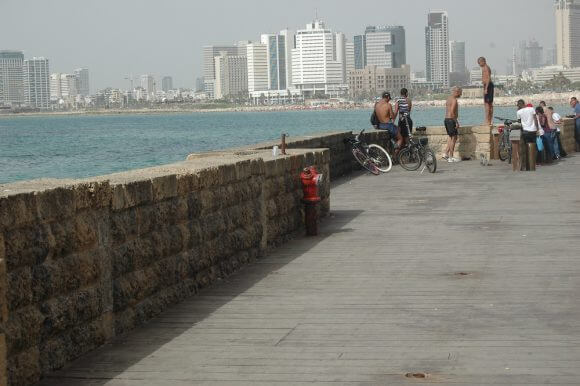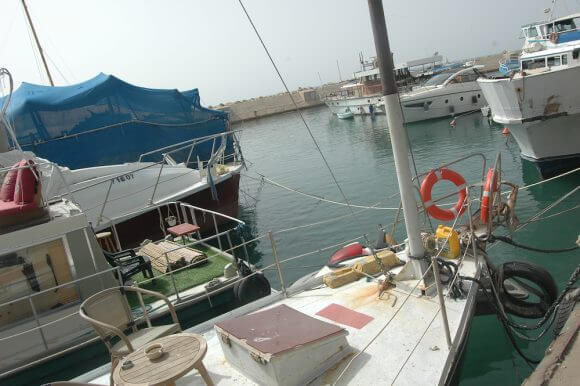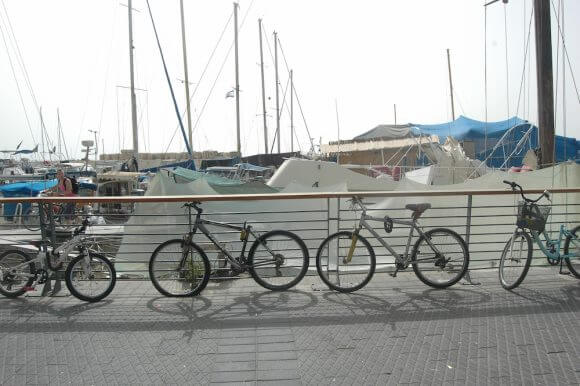Jaffa fell during April 1948 in a swift military operation by Zionist militias that bombarded the then-largest city in Mandate Palestine from three sides. Only the sea-bound route offered a safe escape, and that is why Palestinians this year took a boat tour to commemorate their expulsion off the tepid shores of the coastal Mediterranean city.
Aboard, three men named Omar– one spelled Umar– recalled Jaffa’s past before the creation of the state of Israel and during its sacking.
“Take a look back at the coastline,” Umar al-Ghubari instructed as the fisherman’s boat headed out towards the horizon. Behind him amber stone buildings ascended on a steep bank. The crowded structures together resemble a rampart, interrupted by a lone red and white lighthouse and two minarets. To the south a natural harbor blocks the view of contemporary architecture and so all the eye can take in is Jaffa’s Palestinian past.
To the north, gray skyscrapers, Tel Aviv.
“Of course the state of Israel has changed the view and the landscape of Jaffa,” al-Ghubari said.
It is this week when Israelis and Palestinians memorialize the events that built a nation-state and created a stateless nation. May 15th annually marks Israeli Independence Day, yet the counter narrative is the Nakba, literally the “catastrophe” in Arabic, in which the heirs to Palestinian houses, farms and a once thriving society remember their destruction and start of their refugee crisis.
Between 1947 and 1949 at least 750,000 Palestinians were forced over borders or fled. Today the number of Palestinian refugees has expanded to more than seven million after three more generations were born in diaspora. They are the largest long-standing refugee nation in the world.

Youths jump from the sea wall at north end of the Jaffa Port into the Mediterranean Sea. (Photo: Allison Deger)

Boats docked at the Jaffa Port. (Photo: Allison Deger)
“People leave for natural reasons during a war and the prevention of their return is transfer,” al-Ghubari said, adding, “Israel continues to prevent their return until today.”
In Jaffa, 120,000 people vacated the city in 1948. By the time a ceasefire was declared only 4,000 Palestinians remained. The newly established state of Israel then rounded them up and relocated the group to Ajami, a southern quarter in Jaffa.
“All of the entrances and the exits were closed off and Israeli soldiers were posted at the border,” explained al-Ghubari, “Among both Israelis and Palestinians the neighborhood became known as a ‘ghetto’.”
Today Ajami is a mix of Arab and Jewish populations, in which many Palestinians live in modest homes while Israeli Jews tend to reside in McMansions with sea views. The atmosphere is serene with one of the most maintained beaches in the Tel Aviv area. There are cabanas and tourists drinking afternoon cocktails. Yet intermingling of the populations is sparse, with many Palestinians viewing their Jewish neighbors as people who were afforded great privilege at their direct expense. A number of the villas in Jaffa inhabited by Israeli Jews were formerly owned by wealthy Palestinians who lost everything in 1948. For that generation, the pain of their deprivation has not withered.
“This country needs some new ideas,” said Omar Dajani, a mid-40s vacationer from Norway of Palestinian heritage. Dajani caught the boat in Jaffa after emailing around Israeli human rights groups while on a personal roots tour to see the places of his father’s childhood. He traveled alone. His father who is now 80 has never returned; “he has lost too much to stand it,” Dajani said.
In Jaffa the Dajani family name harkens a time of past prestige, of a distinctly Palestinian-Arab sort. Before their diaspora the clan made their fortune in agriculture and were prominent landowners. Jaffa’s first modern hospital took the Dajani name after an endowment. Dajani said his father was treated there for an ear infection with penicillin shortly after the first round of mass production of the antibiotic, a sign of Jaffa’s affluence and modernity.
Dajani tracked down that hospital.
“I found the fountains in the garden,” he said of the old medical facility. The fountains were just where his father told him to look. When he laid his eyes on them, it was like seeing through time: “I got something back.”
“It showed we were a really strong, well established society in Palestine and we must live in the future together,” he said.
Other memories of the past end on a more somber note.
The third and final Omar on the vessel, Omar Siqsiq, born and raised in Jaffa, teared up as he recalled meeting Palestinian refugees from his hometown in Jordan several years ago.
“I met there people from Jaffa and we talked and there was also an older man who was not talking,” Siqsiq said. After much prodding finally the gentleman explained he has been short of speech since 1948 when he and his family fled on a boat. This man’s youngest son fell off of the raft and drowned after the others refused to turn back for him.
“I put myself in his the shoes of this person and try to imagine what he felt,” said Siqsiq. Umar al-Ghubari gently squeezed his shoulder in a consoling manner.
Siqsiq’s family too used to be landed aristocracy in Jaffa. After 1948 the state of Israel nationalized all of their citrus groves. They were then given a 15 year lease from the government, and later a reduced rent, “as supposed compensation,” Siqsiq lamented.

Bicycles rest against a rail at the Jaffa Port, May 14, 2016. (Photo: Allison Deger)
For the three Omars, Jaffa’s past was still all around them, but ever shrinking. Omar Dajani said there was a vast difference in the number of historic places from his first trip in 2000 compared to today.
“Too many things are being erased fast,” he said.
Umar al-Ghubari said the demolition of Palestinian buildings was deliberate as a move to cover up what once existed.
“The Zionist movement thought the destruction of cities would be a serious blow to the Palestinians” in psychological and national sense, he said.
As the hull careened back towards Jaffa’s port for the return leg of the sea journey, al-Ghubari recommended the passengers consider the ride a symbolic gesture “from exile to homeland. In fact this is the name of the tour,” he said, riffing off of the title of a poem by the prized Palestinian author Shafiq al-Hout who wrote “From homeland to Exile,” years after he was expelled from Jaffa to Beirut during the 1948 war.
But unlike the boats of 1948, this boat would return to the shore from which it departed.
Source Article from http://mondoweiss.net/2016/05/sacking-palestinian-narrated/
 RSS Feed
RSS Feed













 May 15th, 2016
May 15th, 2016  Awake Goy
Awake Goy  Posted in
Posted in  Tags:
Tags: 
















